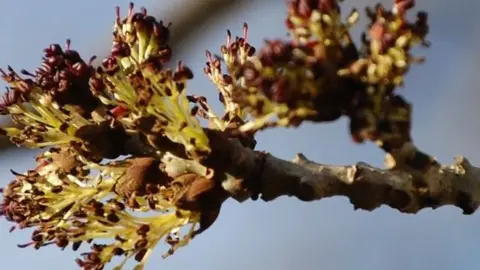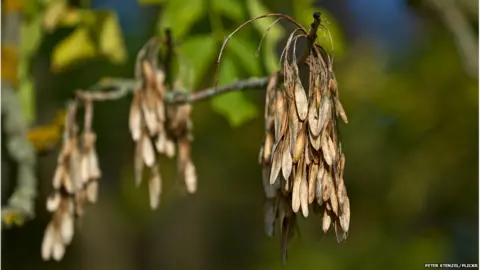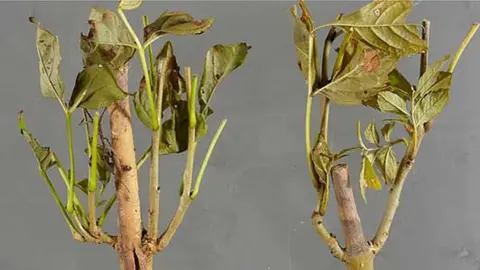Some landscapes show resistance to ash dieback
 BBC
BBCA study suggests that some types of environment help block the spread of ash dieback disease, which threatens millions of ash trees in the UK.
Landscapes with hedgerows and woods made up of several types of tree resisted the pathogen better than areas where ash trees predominated.
The deadly fungus had been present in Europe for a number of decades before it arrived in the UK in 2012.
The findings have been published in the Journal of Ecology.
Ash trees are one of the UK's most abundant tree species. And it's estimated that ash dieback, could cost the UK economy billions of pounds.
The fungus that causes ash dieback causes the loss of leaves and leads to parts of the tree dying.
The researchers looked at the disease's progress in an area of north-eastern France, monitoring the initial stages of its spread during 2012, which was about two years after the fungus was first recorded in the area.
They then assessed the same area again between 2016 and 2018 once the disease had a chance to establish itself in the countryside.
Benoit Marcais, director of research at the French National Institute for Agriculture, Food, and Environment (INRAE) explained that understanding how the landscape affected the spread and severity of the tree disease was important from a scientific and practical point of view.
"(The) arrival of ash dieback close to my lab in a diversified landscape, with ashes in contrasting situations, offered a good opportunity to make some progress in the question," he said.
Rising from the ashes
Referred to as the common or European ash, the tree - the UK's only native ash species - is scientifically known as Fraxinus excelsior.
Within the UK, it is the third most abundant species of broadleaved tree (after oak and birch), covering 129,000 hectares of woodland.
Ash is a highly important species within the UK's hedgerows and accounts for about 10% of the nation's estimated 123 million "non-woodland" trees.
Ash dieback first arrived on UK shores back in March 2012, when it was found on some ash trees in a nursery. In October of that year, tree lovers' worst fears were realised when it was found in the wild, within a woodland in Norfolk.
Since then, the disease has spread to all parts of the UK. A recent estimate suggested that ash dieback would cost the UK economy £15bn. This estimate arises from the cost of clearing up dead and dying trees and includes lost benefits provided by the trees; through water and air purification and locking in carbon from the atmosphere.
 Peter Stenzel/Flickr
Peter Stenzel/FlickrDr Marcais and his team monitored a network of plots in north-eastern France, looking for evidence of dieback on trees, as well as the presence of the fungus that causes the disease - Hymenoscyphus fraxineus - in the forest litter (the mixture of leaves and other organic material on the forest floor).
He told BBC News that the micro-organism spread quickly and efficiently throughout the study area within a few years of being first recorded.
Manna from science?
The study revealed surprising results, as Dr Marcais explained: "Ash dieback, however, shows very contrasting severity depending on the environment, remaining mild on trees in open canopies (hedges, isolated trees) or on trees in forest with a mixture of tree species and just a few ashes," Dr Marcais observed.
However, locations that had a high density of ash trees, such as ash woodland, did display the consequences of being severely affected by dieback.
Diseased saplings typically display dead tops and side shoots. Lesions are often found at base of dead side shoots. Meanwhile, lesions on branch or stem can cause wilting of foliage above. The disease affects mature trees by killing off new growth.
Dr Marcais said it was surprising to record a high amount of the fungal pathogen in the forest litter yet seeing such as contrast between areas with a high density of ash trees and those areas, such as hedgerows, with a lower density of the trees.
 Forestry Commission
Forestry CommissionReassuringly, the findings from the study seemed to support the growing scientific view that the disease will not wipe out ash trees from the landscape in Europe.
But, he added: "The work helps identify the situations where ash is little-affected by ash dieback.
"In particular, we identify that under a certain ash density, the disease will remain mild."
The findings will be welcomed by foresters and policymakers alike, who have been "keen to have more precise thresholds of ash density to improve management, as ash is already common in mixed tree species stands".
However the silver lining this study provides still surrounds a very dark cloud, which tells us that pure ash woodlands are "very harshly struck by the disease".
